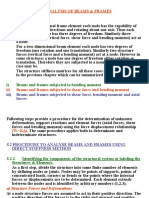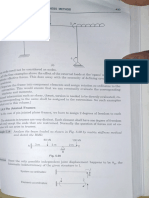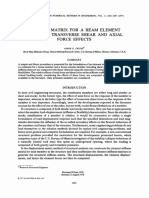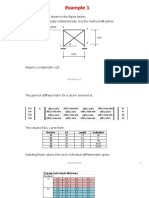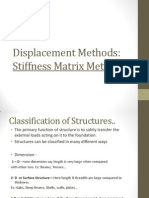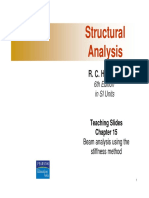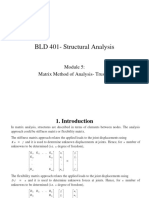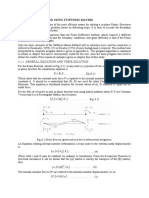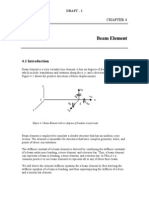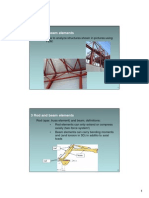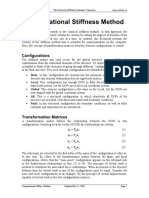0 ratings0% found this document useful (0 votes) 89 views123 pagesMatrix Stiffness Method
Copyright
© © All Rights Reserved
We take content rights seriously. If you suspect this is your content,
claim it here.
Available Formats
Download as PDF or read online on Scribd
CHAPTER 5
MATRIX STIFFNESS METHOD
re
5.1 NOTATIONS
ee
{8} element displacements
{P} element forces
{u) system displacements
\F) system forces
{k,] stiffness matrix of element n
[K] system stiffness matrix
[kl assembled element stiffness matrix
{B] transformation matrix
(P°) forces in element co-ordinates in the fixed state
{F} forces applied at system co-ordinates
(F°] forces at fixed co-ordinates
{P'} element forces consistent with displacements
{Pf} final forces
5.2 INTRODUCTION
i SS
Stiffhess method is the more popular younger brother of Flexibility method. Although
the two methods are the opposites to each other, they are akin to each other in several respects,
Like Flexibility method, stiffness method also involves generating element matrices,
assembling them to get the system matrix and inverting the same to solve for nodal
displacements, member displacements and eventual:
ly member forces. In the solution of a
structure the important result is the member forces. Displacements are generally of lesser
importance.
However in Stiffness method, we get to the displacements first and thence
to member
forces.
5.3 KINEMATIC INDETERMINACY
In the Flexibility method the difficulty of solving a structure increases with the static
indeterminacy of a structure.
In Stiffness method the difficulty increases with its kinematic indeterminacy. Thus,
structures with more constraints (suj
ipports, fixities etc.) are more easily solved than structures
with more freedom. Strangely, the structure in Fig. 5.1 (a) is easier to tackle than the structure
in Fig. 5.1 (b)
397�(a) (o)
Fig. 5.1
We have to get familiar with kinematic indeterminacies (or freedoms). Figure 6.1
has three freedoms as shown and Fig. 5.1 (6) has five and thus more complex for Sti
methods.
By flexibility method the frame in Fig. 5.1 (a) would have been more compl
(indeterminacy of three) than that in Fig. 5.1 (6) (indeterminacy of one).
Example\GAl| Determine the kinematic indeterminacies of the frame and beams in Fig. 5.2.
ja ae |
(a) (bo)
™~
a= & &
© @
Fig. 5.2
(a)
a
(b)�MATRIX STIFFNESS METHOD =
OT —"
Geen,
Kl=3
rs ()
EX
_-
()
Fig. 5.3. (a) to (a)
5.4 GENERATING STIFFNESS MATRICES
‘The n xn stiffness matrix of a structure with a specified set of n co-ordinates is determined
by applying one unit displacement at a time and determining the forces at each co-ordinate to
sustain that displacement.
For example, if we want to determine the 3 x 3 stiffness matrix for the structure in
Fig. 5.1 (a).
(@ Find the forces at 1, 2 and 3 when displacement at 1 is unity and displacements at 2
and 3 are zero, i.e., find P,, P, and P, when 5, = 1 and 6,
constitute the first column of the stiffness matrix [h |.
(ii) Find the three forces at 1, 2 and 3 when 6, = 1 and 8, = 6, = 0. These three forces
constitute the second column of the stiffness matrix [,].
(iii) Find forces at 1, 2 and 3 when 6, = 1 and 6, =
column of [
Examples 5.2 to 5.5 demonstrate this procedure.
0. These three forces
0, These three forces make the third
Determine the 2 x 2 stiffness matrix of the two co-ordinate systems shown in
Fig. 5.4,
Soe ee eee eee, es
1 A B 2
i=22, E=1, lel, As2
Fig. 5.4
olution (41,,, of AB is developed in two steps:
(® Apply 8, = 1 and restrain 2 (, = 0)
aaa 8
Se
3,=1 a=0���‘402
ere the right end settles
end wil be SE! (anti-clockwise.
Fig. 812
For equilibrium, the reactions willbe such that
(Left up and right down, since this has to
develop a clockwise moment.)
Hence the forces al 22EV gong = SEE which form the
first column of the stiffness matrix. To develop the second ¢olumn of the stiffness matrix,
Apply unit displacement along co-ordinate (2) only (keeping displacement along 1s zero.)
ig co-ordinates (1) and (2) are
Fig. 5:13
We know that the moment required at the near end to cause unit rotation, the far end
4EL
being ined is $F! and this will induce a carry over moment of half the value and in the same
direction, ie, 2Et
T�MATRIX STIFFNESS METHOD ie
a
14
Reactions : 2. ST nxteo
) * )
6El
R= x (Left down, right up)
6EL 4EI
Hence the forces developed along the co-ordinates (1) and (2) are — —,-and ——
respectively which form the second column of the stiffness matrix. Hence the stiffness matrix
is
12E1 6EI
3) ae aie
W=| ber der
2 l
12 -6r
k= —
w= 7p ee |
BRRPIEEE) Develop the stiffness matrix for the beam element shown in Fig. 5.14 with
respect to the degrees of freedom shown.
L 2
— aa
EI = constant :
aks B
_———
Fig. 5.14
elwEIGH] The size of the stiffness matrix is 3 x 3. The stiffness matrix will be obtained by
applying unit displacements one at a time, (with no displacements at any other
co-ordinate) and obtaining the forces in each of the co-ordinates,
(To generate the first column of the stiffness matrix, apply unit displacement along
co-ordinate (1) only.
o
-—— — |
Fig, 5.15. Unit displacement applied along co-ordinate (1) only.
ky = Force developed along co-ordinate (1) due to unit displacement along co-ordinate
(Q) only = a ;
Ths is the moment required to cause unit rotation at the near end without translation,
the far end being fixed.
eee ee 2a ani SE�- STRUCTURAL ANALYSIS-|
2EI
oe
heyy =0*
(ii) To generate the second column of stiffness matrix, apply unit displacement along:
ordinate (2) only.
i
i
4
(iti) To generate the third column of the stiffness matrix, apply unit displacement along
co-ordinate (3) only (axial displacement). '
ky 50 k=O y
2 |
B i
i
A t ee A i
eis
_| #381 481�MATRIX STIFFNESS METHOD 405
1
Fig. 5.18
‘Solution To generate the 4 x 4 stiffness matrix, apply a unit displacement along each of the
4 co-ordinates, one at a time and find the forces developed in all the co-ordinates.
These forces are the stiffness co-efficients,
‘To generate the first column of the stiffness matrix, apply a unit displacement at 1 only,
taking care that the displacements at 2, 3 and 4 are kept zero.
ie,
=6,=0.
é 6!
6EI
7
126! 1261 1261 1261
? cee f
()
24E1 12a
@)
Fig. 5.19
‘The forces consistent with 5, = 1 are shown in Fig 5.19 (b) and (c). These are summed up
and shown in Fig. 5.19 (d). Hence the first column of [k] matrix is,
24681 12EI eat) r
ie a ap�406 STRUCTURAL ANALYSIS-|
Likewise, to generate the second column of (k], apply 8, = 1 and 8,
forces developed are shown in Fig. 5.20.
Fig. 5.20
SEI _ 661 2EI]"
ji Be ma
and 6,
Thus the second column of [h] is [o
To develop the third column of [A], apply 6.
are shown in Fig. 5.21.
0. The forces developed
&=1
(o)�ae
~6EI ?
ft
-6El
() a
Fig. 5.21
’ ~12EI -6EI 1261 -6EI]"
The third column off is |e SEE ET 8 |
‘To generate the fourth column of (A), apply 8, = 1, 8, =
oz
Ones
,
(o)
Fig. 5.22
The fourth column of (£] is therefore, (=
Hence,
24
EI| 0
(k] = P\-12
6L
261
I
0
2
-61
i
—6El
41
-6EI 4&1)"
ie a
-12 61
-6l 27
12 -61
-6 4P�408 STRUCTURAL ANALYSIS!
COMBINING STIFFNESSES
‘A structure is almost invariably made up of several elements. Some are capable of
taking up direct forces only (tension or compression). Beam elements can take up direct forces,
shear, bending and torsion. A structure can be made up of either one type of elements or the
other or both. We will see here how stiffness matrix ofa atructure can be developed by combining
the stifffiess matrices of its elements. Examples 5.7, 6.8 and 6.9 show how to combine stiffness
terms of elements.
A B s
— —> =>
1 2 3
Fig. 5.23,
A structure ABC is made up of two elements AB and BC as shown in Fig. 5.23,
1-1
The stiffness |k,| of AB is is 4
i ep) of BC le?
The stiffness UkslofBCis| yy
Find the stiffness (le) of ABC.
(Solution For problems like this it's better to systematise a procedure
later be extended to be adopted in computers.
Step 1: Number all the elements co-ordinates.
as below that cam
aa.
2 3
stiffness matrices [k,] and (ky! to get}, the assembled
5
Step 2: Put together the element
element stiffness matrix.
ee.
Eaten
tk) = 2-2
Blea 2
Step 3: Number the system co-ordinates.
z ae
=
ct
Step 4: eae the system co-ordinates and the local ( or element } co-ordinates as under
Local System
1 1
2 2 .
3 2
4 3�—
MATRIX STIFFNESS METHOD 4
5: Rewrite the elements of the [A] matrix on a 3 x 3 framework using the relationshi
in step 4 above, to from the system matrix [K]
te. 10
(Kl=]-1 3 -2
0-2 2
This method can be called Rubinstein’s method.
Example 5.8) Two springs of stiffnesses 20 N/mm and 30 N/mm are connected in series.
Find the stiffness matrix of the assembly for the three co-ordinates shown in
Fig. 5.24.
k=20 k=30
Fig. 5.24
Boliition The clement stiffness matrices are as under:
1 2
7 WvvvvvoMUTHUUUUHUIUN > —* VO 00000000000 +
1 @ 2 ®
ke 20 -20 : hal = 30 30
Ml=)_99 20] ' Ual=!_—30 go.�‘The relationship between element and system co-ordinates (connectivity) 18 a8 below
System
‘Example 5.9 “Assemble {h,} and {hs} of the two element frame in Pig, 6.25 to generate (K] of
the system.
&
1 2 G
(l= " 2]
met
eet (b) System�MATRIX STIFFNESS METHOD a
Solution Re-number the co-ordinates of the elements as under. Write [k], the assembled
element stiffness matrix,
42
ae cs
(0) 42 a
Tabulate the connectivity
Local System
1 1
2 2
8 2 me
4 3
Generate [K]
4/2 0|0
2/4 ofo e pe
[Kk] = olo 4/2} = 2/8/2
oto ata| lolzl4
5.6 GENERATING STIFFNESS MATRICES DIRECTLY
The [hk] matrix of a structure for a given set of co-ordinates can also be generated directly
without taking recourse to the assembling techniques adopted in the earlier examples. The
procedure is exemplified in examples 5.10 to 5.14.
Example 5.10 Generate the stiffness matrix for the structure with co-ordinates as shown in
Fig. 5.26.
Fig. 5.26�412 STRUCTURAL ANALYSIS-I
Solution There are two co-ordinates as shown. Hence the size of the stiffness matrix will be
2x2
Applying unit displacement along co-ordinate (1) only.
6El,
coontnate IN 7
Fig, 5.27
Applying unit displacement along co-ordinate (2) only.
ae =~
Co-ordinate - ~~
se,
=
4, 34)
Tae�MATRIX STIFFNESS METHOD 413
12EI, 6EI,
Hence the stiffness matrix ,(K} =| 4° hy
SEI, 4K, , 3EL, |’
ey
pxample 5.11 Generate the stiffness matrix for the structure with co-ordinates shown
in Fig. 5.29.
ee 3
El = Constant
t
tif
|)
Fig. 5.29
Solution There are three co-ordinates in the given structure. Hence the size of the stiffness
matrix will be 3 x 3. To generate the first column of the stiffness matrix apply unit
displacement along co-ordinate (1) only with zero displacements along co-ordinates
(2) and (3)
4 1 i
Co-ordinate (1), ~~ 11 12E|__, 4 1
i
Fig. 5.30�414 STRUCTURAL ANALYSIS-1
Reactions : SEL SEL _ pete
er
CG CG CD)
R= 12EL (Top-right ; Bottom—left)
s
Combining the terms along the given co-ordinates only
6EI
oF pel
a oS
Be
e
First column
[ 241]
til tii?
Fig. 5.31
To generate the second column of the stiffness matrix, apply unit displacement along
co-ordinate (2) only. (Fig. 5.32)
+ 281
T
4B) y_Cocorsinate (2)
1
IB
Fig. 5.32�Column reactions ; “ a axleo
l
(© ()
re 6EI left)
a (Top - right ; Bottom —
Combining the terms along the co-ordinates, we get the second column.
BE! 2E1
sel O 7 er
f
Second column
‘GEL
2
SEL
7
EI
7
Fig. 5.33
| To generate the third column of the stiffness matrix, apply unit displacement along co-
ordinate (3) only. (Fig. 5.34)
ae
-—x*�b——— + ——_4
Fig. 5.35
‘Solution develop the stiffness matrix for the structure, unit displacements are applied
i apt each of the four co-ordinates, one at a time and the forces along the given
are determined.
_ To develop the first column of the stiffness matrix, apply a unit displacement along co-
with the condition that no displacement occurs at 2, 3 or 4. Now determine
Bend 4.
eh me toe 5 :
; | + ae
i 12E�—
MATRIX STIFFNESS METHOD a?
EE eee
Reactions : SP ET erat
©)
Rao (Top - right ; Bottom ~ left)
osiecing; and shonting vat eele along the co-ordinates
GEL 6EL
ager ae
6E)
5
Fig. 5.37
To develop the second column of the stiffness matrix, apply a unit displacement along
co-ordinate (2) only.
4EI aa
"art
GELS, ea
t
4EI t
sel «SVT ay
a
N
: 7 ss
vad Z
6EL
Co ae
Fig. 5.38�eS q
418 STRUCTURAL ANALYSIS-|
Reactions : a + 2B =Rxl
(DD
Re a (Top - left ; Bottom ~ Right)
4E1 , 4El SEL
t \ v 2EL
Lad oNt
=
?
oe
Combining i
2EL
Fig. 5.39
To develop the third column of the stiffness matrix, apply unit displacement along
co-ordinate (3) only.�MATRIX STIFFNESS METHOD 419
261
6EL :
ei a
4EL ia 4EI
I I
- 6EI
ii
Combining oEI
Tae
GET,
i
EL
U
J 2EI
Fig. 5.41
To develop the fourth column of the stiffness matrix, apply a unit displacement along
co-ordinate (4) only. (Fig. 5.42)
281
I
— ont
?
aa.
4EIN TZ E�STRUCTURAL ANALYSIS-I
aed cy 2E1
Combining
Fig. 5.43
Hence the stiffness matrix for the structure,
24El -6EI -6EI -6EI
e E ie
8El 261
1 l |
2El 8EI 2E1 |
I I I
o 2 el
I ae
~6l -6! -61]
ae oro |
6 2? Bi? 2/7
[6 Doe 4" |
Example 5.13 Generate the stiffness matrix k for the following structure in Fi 2. 5.44 with
co-ordinates as shown
ne S 7�421
ites. Hence the size of the stiffness matrix will be 4 x 4,
matrix will be devel, ; ’
of the co-ordinate, one at ee % applying unit displacements along each
Poa e forces developed 1, 2, 3 and 4 will be
‘To generate the first
column of the stiff; tri ast
ordinate (1) only. (Fig, 5,45) ness matrix, apply unit displacement along co-
28
wyxt ee
\ 2E1
\ \ =i
Ni \ 0
7 G
4EI Co-ordinate 1
= a
a
Foree along co-ordinate (1) = a,
Ww
Foree along co-ordinate (2) = a ()iandiso. on.
Applying unit displacement along co-ordinate (2) only, (Fig. 5.46)
i.�STRUCTURAL ANALYSIS-|
Second column
on
: 2 4
ic ) Poet
a
4EL , 481
:
ter, | Aa
EL
| t
Se
eal
7
Fig. 5.46
Applying unit displacement along co-ordinate (3) only. (Fig. 5.47)
a
aa
Third column
[ 2er ]
7
oO
SEL,
7
\ 2El
\ ig
“et
i [7 Co-ordinate(3) !
anh a
=
: Fig. 5.47
et�MATRIX STIFFNESS METHOD -
Applying unit displacement along co-ordinate (4) only. (Fig. 5.48)
: 4B1
Co-ordinate (4) et
I
"rr
Fourth column
0
. 2EL
tT
2EI
t
SEL
T
A er
T
Fig. 5.48
Hence the stiffness matrix,
[SEL 2EI 21
| ies te
| 2E1 SEL, 2E
L l L
(KI=) pet SBI 261 |
|r is, t
21 2et sel
[ E L t
Fig. 5.49
NE, insists tine ciitnens wantin, Int via aaply. unis Waplanamans in Sei ati
co-ordinates (1), (2), (3) and (4) separately and find the forces developed in the 4
—�424 STRUCTURAL ANALYSIS-1
Applying a unit displacement along co-ordinate (1) only and not allowing displacement
in any other co-ordinate, the forces developed in the co-ordinates are determined ang
Tepresented as the first column of the stiffness matrix.
SEL _ 4x2 _ R=12
o
6EI_6x2
Re->=— = 12
! -
Hence the first column of [k] is
12
Applying a unit displacement along co-ordinate (2) only (Fig. 5.51), the second column
of the stiffness matrix is obtained.
Gi
Fig. 5.51
2 2 ay
ee
_ SEI _ 6x1
waa =6
l L
Rxl=
°
4
Hence the second column of [k] is
-6
Applying a unit displacement along co-ordinate (3) only the forces at the co-ordinates
are as under.�MATRIX STIFFNESS
——————————————
6EI_6
= ea
12
S41.
BI -2*2-4 6 =
ol
2EI 2x19
Hence the third column of (/] is
6
Applying a unit displacement along co-ordinate (4) only the forces are as below
6EI_6x2_
ae
12 6EI_6x1
2
Hence the fourth column of [4] is e
36
8 0 4 +12
4 2 -6
Hen i ix is () =
ce the stiffness matrix istkl=| 4 9 19 |:
12-6 6 36�to explore ways and
One has to reme mber that matrix
the method will prove to be
slems for solution by this
ther methods
h effort by ot
ms is necessarily
ww to generate stiffness matrices, the next step
t to analyse simple structures:
rs, If manually done
1 take only simple prot
ably one tenth as muc
f these proble
Having learnt ho
ng the concep!
use with compute
d tedious. So, we ¥?
rn be done with prob
deflection. The PUFF
means of usil
methods are meant for
systematic, repetitive am
method. These problems ca!
such as moment distribution or slope
to help evolve the computerisation process
‘The following steps can normally be adopted to analyse be
members.
Step 1. Assign system co-ordinates. Normall
anknown nodal displacement
pose 0
ams and frames with flexural
y one co-ordinate shall be assigned to each
to component units of elements Assign nodal co-ordinates
Step 2. Split the structure in
for the extremities of each element.
Step 3. Evaluate element forces. For flexure membe _ these forces are usually support
moments and reactions due to forces not acting at the co-ordinates
Step 4. From the [B] matrix. This is similar to the [6] matrix defined in Chapter 4,
Flexibility method. Examples 5,15, 5.16 and 5.17 show how B matrices are computed.
{B] connects the system displacements (u} and the clement displacements (6)
Step 5. From the element stiffness matrices [hy], Ue) [e,] for all the elements in the
structure, form {k] the assembled element stiffne matrix.
| mo 9 ]
tey=| 0 thal 9
[0 0 thy] |
Table 5.2 summarises the standard cases of element stiffness matr 8.
using the relation [K] = aT" (e) (B)
Step 6. From the system stiffness matrix [K]
Step 7. Get [KI
Step 8 Compute the system displacement vector (u). U
{u) = (KT? (UP) — OF
ments (8} using the equation (8) = [BI (u)
s (P*) using (P) = (k} (5h
(Pp) +P
d the free bendin,
sing the relationship,
displace!
ponding element force
(P/ are given by (P=
ents diagram ani
Step 9. Get the element
Step 10. Get the corres
Step 11. The final forces
Step 12. Sketch the end mom
superposed on it.
It may be note
proof. For proof the
Above are borrowed from the
meticulously follows this step
g moment diagram
en without @ valid
ts listed
sh 6.35)
6, 8, 9, 10 and 11 are giv
ef 9). The steps and concep!
ies (5.21 throug!
.d that equations in steps 5,
reader is referred to Rubinstein (
same (ref 9). Each of the fifteen exampl
by step method of solving structures.

